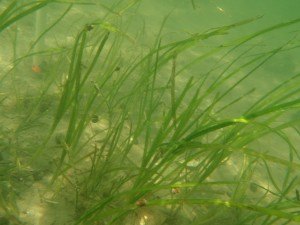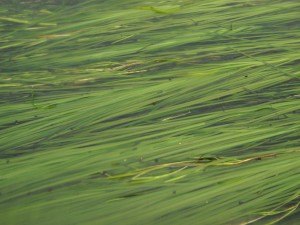Eelgrass in Maine is now closed to new submissions. To share what you’re seeing in the natural world, you can now create an account at CEHL’s new collaborative nature journal, Anecdata!
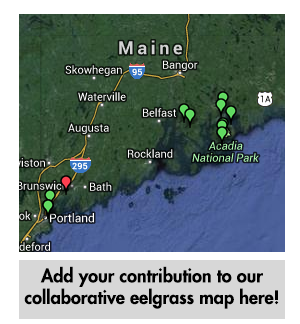 Scientists, interns, and volunteers at the Mount Desert Island Biological Laboratory (MDIBL) have been successfully restoring eelgrass in Frenchman Bay with community partners for six years. But this year, the marine plant didn’t come up, and not just in restored areas. Eelgrass throughout the upper bay didn’t seem to get its annual signal to send up shoots, and only rhizomes remain in the mud where eelgrass beds had been.
Scientists, interns, and volunteers at the Mount Desert Island Biological Laboratory (MDIBL) have been successfully restoring eelgrass in Frenchman Bay with community partners for six years. But this year, the marine plant didn’t come up, and not just in restored areas. Eelgrass throughout the upper bay didn’t seem to get its annual signal to send up shoots, and only rhizomes remain in the mud where eelgrass beds had been.
In order to find out the extent of this event along the coast of Maine, MDIBL is asking the public to look for eelgrass beds and report their locations, or where they missing from places where there had been beds in the past. The lab is asking people to search for the plant as soon as possible, because eelgrass’s growing season usually ends in August.
The Community Environmental Health Lab (CEHL) at MDIBL is leading the state in restoration of eelgrass, an important plant for the marine ecosystem which provides essential nursery habitat for commercially valuable fish and shellfish, protects against erosion by dampening wave energy, oxygenates the water and mud, stabilizes sediments, improves water quality and clarity, and even sequesters carbon. The lab team and partners have established restoration sites near Hadley Point in Bar Harbor and Berry Cove in Lamoine, and are studying the effectiveness of different methods of eelgrass replanting and fertilization techniques, the broadcast of eelgrass seeds by currents, the population genetics of eelgrass communities, and the diversity of invertebrate populations that live on and around the plants.
This year’s lack of eelgrass came as a surprise when the restoration team was poised to begin its largest restoration effort to date: 228 new acres of restoration areas were approved, voluntary agreements were in place with mussel draggers to not drag in restoration areas which they had helped choose based on suitability of bottom-type, 200 transplant grids were made, interns had arrived, and volunteers were ready to help harvest and replant.
Now the lab is changing gears and working to understand the cause of the loss and its extent. They are documenting everything they can about the conditions in Frenchman Bay, and setting up experiments to compare different factors between the few sites where eelgrass is growing and those where it is not. They want to know where else eelgrass has been lost on the coast, to see if there is a pattern which can help them determine a cause. Because eelgrass is not regularly monitored by the state, and because of the short timeframe left for gathering data for this season, the lab decided to crowdsource the mapping project. Anyone who walks the beaches, explores the islands and coast, goes sailing, kayaking, or otherwise has access to areas where eelgrass may be present can assist this project.
Where to Look
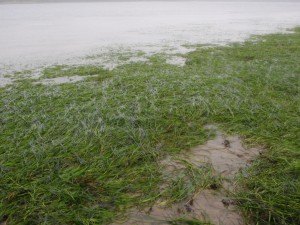
Eelgrass grows in estuaries, near freshwater outlets, and in shallow coastal waters where light can penetrate to its leaves.
A good place to start looking is where the DMR maps of eelgrass show eelgrass as being present in 2001-2010. Eelgrass is a dynamic plant; the beds change shape and new beds come up year to year, so there may be beds in other places than are shown on the map. Wherever you do find it, or if you don’t find it in the places where it had been, mark the locations on the collaborative map, and fill out the form with as much information as you can, or contact the lab at 207-288-3605 x423 or jbailey@mdibl.org.
Identifying Eelgrass:
The Encyclopedia of Life gives a good basic outline of eelgrass (Zostera marina) and should help you recognize it.
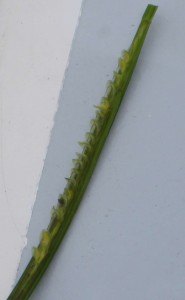
It grows mostly in the subtidal zone, but is sometimes exposed at low tide. Its leaves float up when submerged but lay flat when out of the water, and sometimes especially long blades float at the surface. People often confuse eelgrass with salt marsh grass, Spartina, but unlike eelgrass, that plant is rigid and stands upright when it is out of the water, and is often visible extending above the water at high tide.
Here are some identifying features of eelgrass to look for:
- – Eelgrass leaves are thin, flattened blades.
- – Inner leaves are new growth, older outer leaves begin to decay and fall off throughout the season.
- – Blade length varies depending partially on water depth.
- – The lower portion of the stem is surrounded by a thin sheath.
- – Flowering plants have a spathe with male and female flowers, or may hold ovoid seeds.
- – Flowering plants also have nearly yellow stalks (not all are flowering)
- – The plants are anchored in the sediment with rhizomes, or runners from which other shoots and roots grow.
